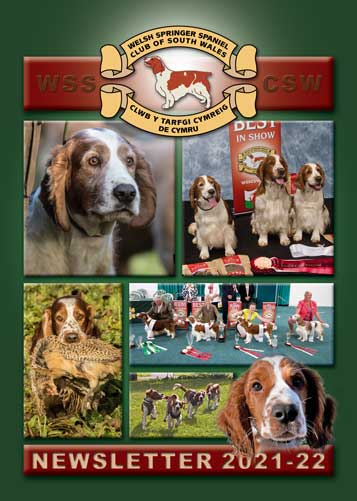Introduction to the Breed
The Welsh Springer Spaniel
John Phillips
Welsh Springers are a delightful, soft-centred idiosyncratic breed and their distinctive red and white colour, handy size, normal structure and photogenicity have rendered them increasingly popular In the show ring, and on the pet food label, in the last 30 years.
They began, when gaining KC recognition in 1902, as working gundogs, thanks to the testimony of Mr A.T.Williams and other landed gentry In South Wales, where several kennels had been kept for well over a century purely for working purposes. They have stayed essentially the same, in type, character and appearance ever since.
It is vitally important for the preservation of the breed's many virtues and overall quality worldwide that temperament, trainability and soundness is preserved through serious training for gundog tests and trials, or agility, obedience, tracking and similar active disciplines. Having been fortunate enough to own Welsh Springers since 1966, to have known all the leading working figures since that time, and to observe the breed in action at such pursuits in the USA, Sweden, Holland, Denmark and France as well of course as the UK, I have no doubt whatsoever of their competence and talent in intelligent and sympathetic lianas.
Numerically relatively small - annual registrations today run at around 500, compared with 13000 English Springers - the Welshmen have never been populous enough to become the common shooung/Working dog, or the choice of the professional trainer. Financial pressures demand a large pool for selection and a quickly trained product. Welshies are slower to mature and to learn than the two dominant working spaniel breeds, so they are not cost effective. Their natural style too, often slower-paced and far more nose-dominated and scent sensitive, does not suit the modern fashion for high speed. In terms of status in the field trial scene, therefore, Welsh are ranked below the working English Springer and working Cocker.
However, sweeping judgements are often wrong, exacerbated by the sight of poor examples. Trials are only the tip of the iceberg - there is a far smaller gap between all breeds, and frankly much overlap, in terms of shooting field usefulness. The virtues of scenting ability, stamina, boldness in thick cover, intelligence and biddability should not be ignored just because electric pace isn't displayed. Undoubtedly it Is the quality of the trainer, and the suitability of his programme, plus capable handling, which dictates the dog's effectiveness. All breeds produce badly trained and controlled dogs, as many shoots can demonstrate!
Welsh Springers are the ideal amateur's dogs, where time spent in training together shouldn't be critical, and good relationships are founded on patience. kindness and intelligent learning techniques. Their merits include being affectionate, clever and perceptive, and they appreciate being reared in a home because they are people-orientated.
The power of their noses can't be stressed enough - it dictates their working style. Thus they excel as game tinders and linehunters, as Hal Leopard wrote - no better dog on runners.
The Swedes value their tracking skills highly: Americans worship their brains and multi-discipline versatility.They are courageous and tough. Some have literally saved the lives of their owners by independent thinking. Wilson Stephens wrote (Gundog Sense and Sensibility) that he considers them the only equal to the working English Springer in thick bramble. But - they do need more time to mature than some breeds of gundog. Though individual dogs can vary widely, they are not computer-Ike instant absorbers of lessons, and many need time and patience In their training. Other defects include a tendency in some lines to whine when keen and give voice on scent, unimportant and even useful at rough shoot level.
Though proscnbed in UK competitions this virtue is expected in France and Europe, where a bell is often attached to the coiiar. Retrieving skills, too. vary considerably, and may well have to be taught patiently over several montns. Most important. and tne essential key to successful training, is this breed's sensitivity - they will not respond well to any kind of 1H-treatment or harsh punishment. Like most humans, they respond far better to praise than abuse, and they learn some things very quickly. Don't go near the boot and stick brigade!












